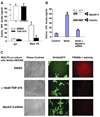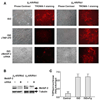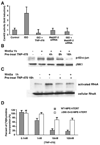A chemical and genetic approach to the mode of action of fumagillin
- PMID: 16984890
- PMCID: PMC2583369
- DOI: 10.1016/j.chembiol.2006.07.010
A chemical and genetic approach to the mode of action of fumagillin
Abstract
Previous mode of action studies identified methionine aminopeptidase 2 (MetAP-2) as the target of the antiangiogenic natural product fumagillin and its drug candidate analog, TNP-470. We report here that TNP-470-mediated MetAP-2 inhibition blocks noncanonical Wnt signaling, which plays a critical role in development, cell differentiation, and tumorigenesis. Consistent with this finding, antisense MetAP-2 morpholino oligonucleotide injection in zebrafish embryos phenocopies gastrulation defects seen in noncanonical Wnt5 loss-of-function zebrafish mutants. MetAP-2 inhibition or depletion blocks signaling downstream of the Wnt receptor Frizzled, but upstream of Calmodulin-dependent Kinase II, RhoA, and c-Jun N-terminal Kinase. Moreover, we demonstrate that TNP-470 does not block the canonical Wnt/beta-catenin pathway. Thus, TNP-470 selectively regulates noncanonical over canonical Wnt signaling and provides a unique means to explore and dissect the biological systems mediated by these pathways.
Figures






Comment in
-
A noncanonical path to mechanism of action.Chem Biol. 2006 Sep;13(9):924-6. doi: 10.1016/j.chembiol.2006.09.002. Chem Biol. 2006. PMID: 16984880
References
-
- Ingber D, Fujita T, Kishimoto S, Sudo K, Kanamaru T, Brem H, Folkman J. Synthetic analogues of fumagillin that inhibit angiogenesis and suppress tumour growth. Nature. 1990;348:555–557. - PubMed
-
- Liu S, Widom J, Kemp CW, Crews CM, Clardy J. Structure of human methionine aminopeptidase-2 complexed with fumagillin. Science. 1998;282:1324–1327. - PubMed
-
- Griffith EC, Zhuang S, Turk BE, Chen S, Chang Y-H, Wu Z, Biemann K, Liu JO. Methionine aminopeptidase (type 2) is the common target for angiogenesis inhibitors AGM-1470 and ovalicin. Chem. Biol. 1997;4:461–471. - PubMed
Publication types
MeSH terms
Substances
Associated data
- Actions
Grants and funding
LinkOut - more resources
Full Text Sources
Other Literature Sources
Molecular Biology Databases
Research Materials
Miscellaneous

